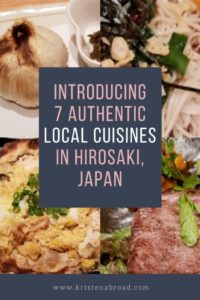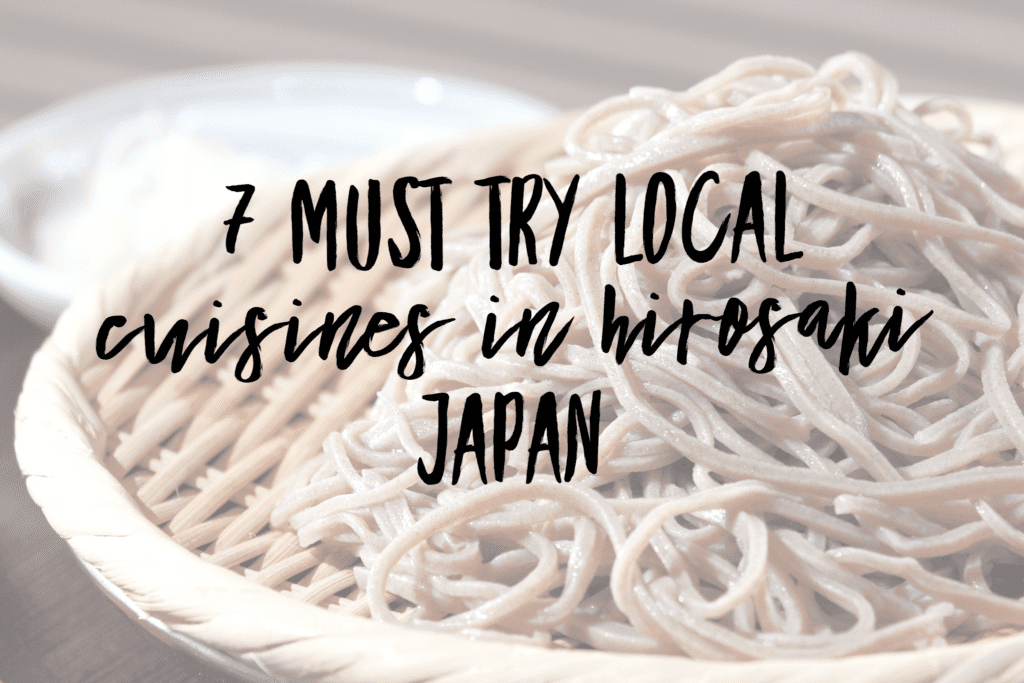You don’t travel around Japan just for the attractions, you do it for the food. It’s Japan, the regional fare is king and Aomori Prefecture had to be known for some local dishes that didn’t have apples involved! Personally, I love finding hole-in-the-wall places, but when you want to ensure you find some local cuisine it helps to do a little research. What were the local cuisines in Hirosaki?
Queue in the local tourist maps – remember, always check in with the local tourism office, nearly every city in Japan has one (at least it feels that way). It’s one of my best tips for traveling around Japan.
[Editors Note: This post originally published in August of 2018 and had been updated for freshness, accuracy, and comprehensiveness.]
Where to find Local Cuisines in Hirosaki
One of the options is けん太旬彩館 Kenta Shunsaikan Izakaya. While it is on the touristy side (it was advertised in the tourism information after all), it definitely fits the bill.
One plus? Have you been to a Japanese restaurant or izakaya where everyone eats in their own private room? Here you can check that one off the experience list! You thought booth seating was intimate? Try tatami mats and shoji doors.
Kenta Shunsaikan Izakaya didn’t disappoint
7 Must-Try Local Cuisines in Hirosaki
1) Hotate Kaiyaki
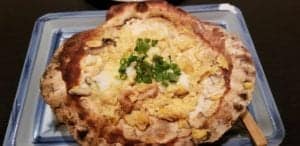
It’s official, there’s nowhere in Japan you can’t get good seafood (surprise, surprise for an island nation). Though this one doesn’t look entirely appetizing in this picture, it was amazing. Being such a large shell, shellfish like this very often in Japan cooked straight on the grill, great for not dirtying up dishes!
The shells aren’t just one time use though. They say that the longer they are used the better the flavors are imparted on the dish. My shell above looks a little worst for wear so I guess that means it’s super yummy!
Cooked in a scallop shell, yes, it includes scallop! Hotate (Japanese for scallops) does have kanji (帆立) but you will normally see it written in katakana as ホタテ. The scallop, eggs, and onion get simmered in the shell in a miso broth.
2) Kenoshiru (けの汁)
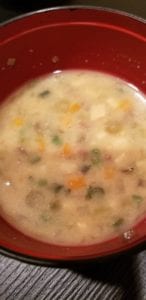
Kenoshiro is a much thicker miso soup than I’ve ever had before. More like porridge, it is full of a variety of root vegetables such as carrot, daikon radish, and burdock. I love burdock! A vegetable I never knew existed until coming to Japan.
Of course, since it’s miso, there are chunks of tofu in it as well (very common but not necessary) and some seasoning that I couldn’t place. Delicious and hearty. Probably much better suited to winter eating but amazing none the less.
It is also eaten as part of New Year’s to wish for good luck.
3) Tsugaru Soba
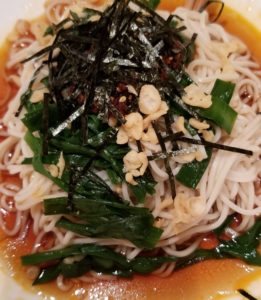
You’ll find consistencies throughout all of Japan on certain dish types but the different regions will have a slightly different take on the preparation. Soba is normally buckwheat noodles, made long and commonly eaten at New Year’s eve to pray for long life.
However not the case with Tsugaru Soba. As far as these local cuisines in Hirosaki go, the soba here is shorter and tastes much softer than normal soba. Why? They don’t use buckwheat but soy flour! It’s apparently also a very labor-intensive process. Cooked with seaweed, soy and usually a fish broth, it’s delicious
Another difference of soba that it’s other noodle friends like ramen and udon, it is normally served cold, so don’t be surprised by that.
By the way, in case you are wondering what Tsugaru means it refers to the western half of Aomori prefecture in the area where the Tsugaru clan ruled over. They are the ones that had Hirosaki Castle.
4) Tempura Corn
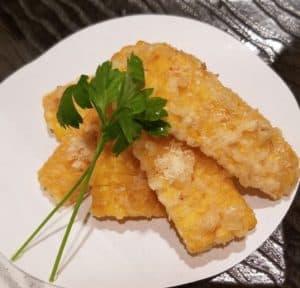
Why isn’t tempura corn a thing everywhere?! After you’ve had this, you’ll never want to have normal corn every again. And that includes the delicious street fair version which is doused in soy sauce and butter.
5) Miso yakisoba
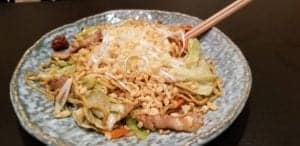
Another “tsugara-region” take on a classic, yakisoba. Slight flavoring differences that what you’ll have further south. Oh, and don’t jab your food with chopsticks like it appears mine was doing in this picture, eek! Good thing for the closed-off rooms?
Of note, how do you get the staff’s attention if you are in your own room? Check your table for a doorbell! The closed-off rooms I believe are where the doorbells came from you’ll see in some restaurants, out of necessity obviously. Another option is to just more loudly say “sumimasen“, which may turn into your favorite Japanese word.
6) Local Garlic
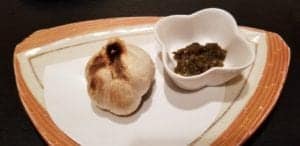
Aomori is the biggest producer of garlic in Japan with Aomori black garlic being something that even Trader Joe’s imports in the states. When in Rome! I kid, I eat enough garlic to keep away vampires for the rest of my life.
If you love (or hate) garlic, look for ニンニク (nin-niku) on the menu which is the word for garlic in Japanese. The miso was also fantastic. My grocery store literally has 40 different types of miso in it and one of my goals is to become a connoisseur of miso!
7) Aomori Wagyu
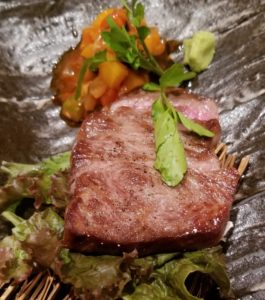
Lastly, if the local beef is offered, I have to try it. Due to the price and size, this was probably A5 Wagyu but I’m honestly not sure, it was still very marbled and delicious regardless.
Other food to try in Hirosaki
Not a food but Hirosaki has a big coffee history. Manchan (万茶ン) opened in 昭和4年 (Showa 4 or 1929 to the rest of us) and is thought to be the fourth oldest coffee shop in Japan and the oldest in Tohoku, Plus any time you get to try a traditional 喫茶 (kissaten, coffee shop) you should take it.
If you are craving some comfort food, Curry and Coffee Kawashima is a fantastic Japanese curry place and you can’t forget all of the apple options around the city. Hirosaki is the apple capital of Japan after all and there is no shortage of apple pie.
You may have noticed all of the western style buildings in town. These Meiji era constructions also are a marker that it had a large foreign population. As such, you will find many French restaurants in town!
Lastly, there was one of the local cuisines of Hirosaki I didn’t get to try it myself but the area is also known for a dish called “igamenchi” or fried minced squid with some vegetables.
If you make it to Aomori prefecture, I hope you can try some of this delicious local cuisine. As always when traveling in Japan, be on the lookout. You’ll usually find that the local tourist centers will give you a hint about w
Can’t make it up to Aomori to try the local cuisines in Hirosaki? There is an izakaya in Tokyo’s Shimbashi area that is all things Aomori (including nebuta!). It’s called Aomori Nebuta World and serves dishes you would find up North!
